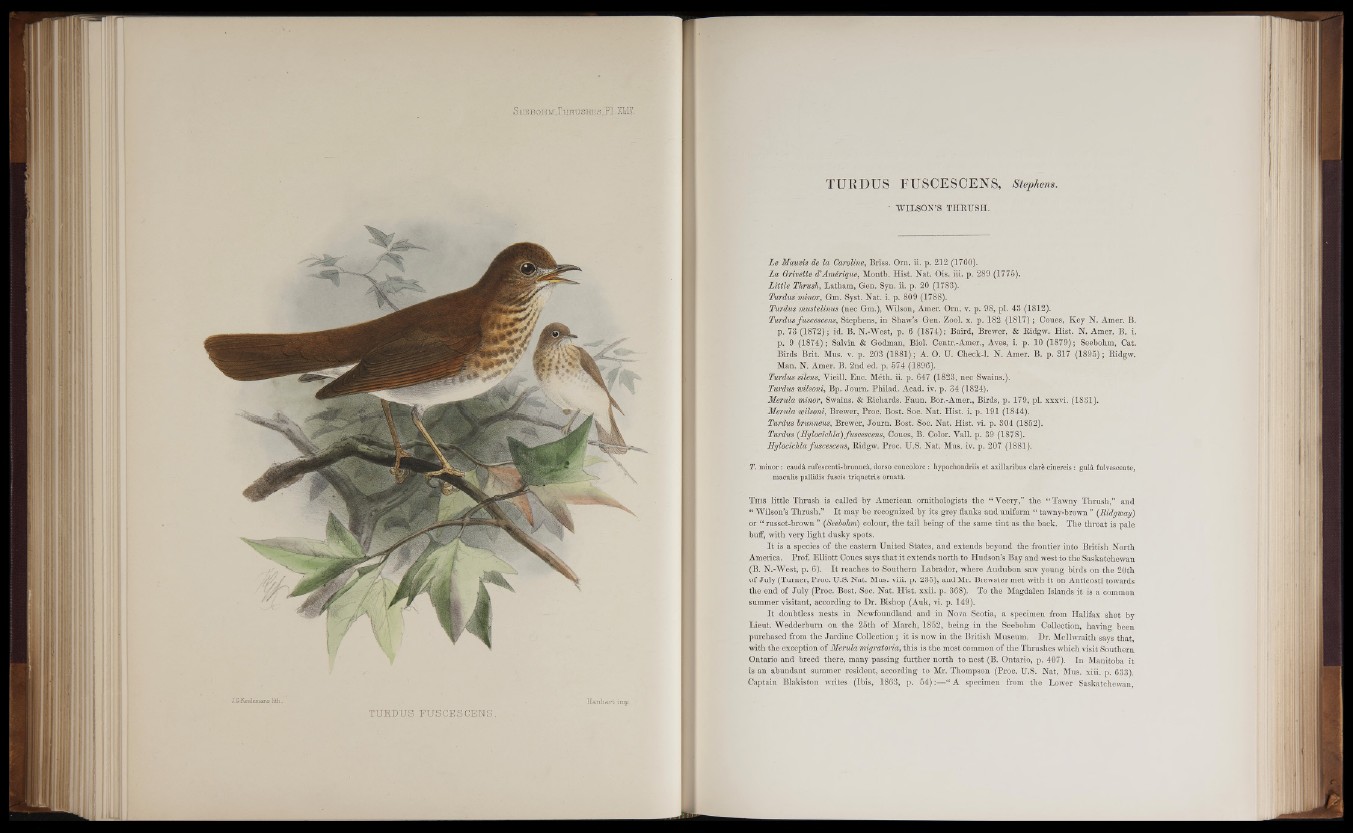
J.G.Keulemans Hth. HanTiart imp.
T U R D U S T V S C E S C E N S .
TURDUS FUSCESCENS, Stephens.
* WILSON’S THRUSH.
Le Mauvis de la Caroline, Briss. Orn. ii. p. 212 (1760).
La Grivette dAmerique, Montb. Hist. Nat. Ois. iii. p. 289 (1775).
Little Thrush, Latham, Gen. Syn. ii. p. 20 (1783).
Turdusminor, Gm. Syst. Nat. i. p. 809 (1788).
Turdus mustelinus (nec Gm.), Wilson, Amer. Orn. v. p. 98, pi. 43 (1812).
Turdus fuscescens, Stephens, in Shaw’s Gen. Zool. x. p. 182 (1817); Coues, Key N. Amer. B.
p. 73 (1872); id. B. N.-West, p. 6 (1874); Baird, Brewer, & Ridgw. Hist. N. Amer. B. i.
p. 9 (1874) ; Salvin & Godman, Biol. Centr.-Amer., Aves, i. p. 10 (1879); Seebohm, Cat.
Birds Brit Mus. v. p. 203 (1881); A. O. U. Check-1. N. Amer. B. p. 317 (1895); Ridgw.
Man. N. Amer. B. 2nd ed. p. 574 (1896).
Turdus silens, Vieill. Enc. Meth. ii. p. 647 (1823, nec Swains.).
Turdus wilsoni, Bp. Joum. Philad. Acad. iv. p. 34 (1824).
Merula minor, Swains. & Richards. Faun. Bor.-Amer., Birds, p. 179, pi. xxxvi. (1831).
Merula wilsoni, Brewer, Proc. Bost. Soc. Nat. Hist. i. p. 191 (1844).
Turdus brunneus, Brewer, Journ. Bost. Soc. Nat. Hist. vi. p. 304 (1852).
Turdus (Hylocichla) fuscescens, Cones, B. Color. Vail. p. 39 (1878).
Hylocichla fuscescens, Ridgw. Proc. U.S. Nat. Mus. iv. p. 207 (1881).
T. minor : caud& rufescenti-brunneS,, dorso eoncolore : hypochondriis et axillaribus clare cinereis: gula fulvescente,
maculis pallidis fuscis triquetris ornatiL
Tms little Thrush is called by American ornithologists the “ Veery,” the “ Tawny Thrush,” and
“ Wilson’s Thrush.” It may be recognized by its grey flanks and uniform “ tawny-brown ” (.Uidgway)
or “ russet-brown ” (Seebohm) colour, the tail being of the same tint as the back. The throat is pale
buff, with very light dusky spots.
It is a species of the eastern United States, and extends beyond the frontier into British North
America. Prof. Elliott Coues says that it extends north to Hudson’s Bay and west to the Saskatchewan
(B. N.-West, p. 6). It reaches to Southern Labrador, where Audubon saw young birds on the 20th
of July (Turner, Proc. U.S. Nat. Mus. viii. p. 235), and Mr. Brewster met with it on Anticosti towards
the end of July (Proc. Bost. Soc. Nat. Hist. xxii. p. 368). To the Magdalen Islands it is a common
summer visitant, according to Dr. Bishop (Auk, vi. p. 149).
It doubtless nests in Newfoundland and in Nova Scotia, a specimen from Halifax shot by
Lieut. Wedderburn on the 25th of March, 1852, being in the Seebohm Collection, having been
purchased from the Jardine Collection; it is now in the British Museum. Dr. Mcllwraith says that,
with the exception of Merula migratoria, this is the most common of the Thrushes which visit Southern
Ontario and breed there, many passing further north to nest (B. Ontario, p. 407). In Manitoba it
is an abundant summer resident, according to Mr. Thompson (Proc. U.S. Nat. Mus. xiii. p. 633).
Captain Blakiston writes (Ibis, 1863, p. 54):—“ A specimen from the Lower Saskatchewan